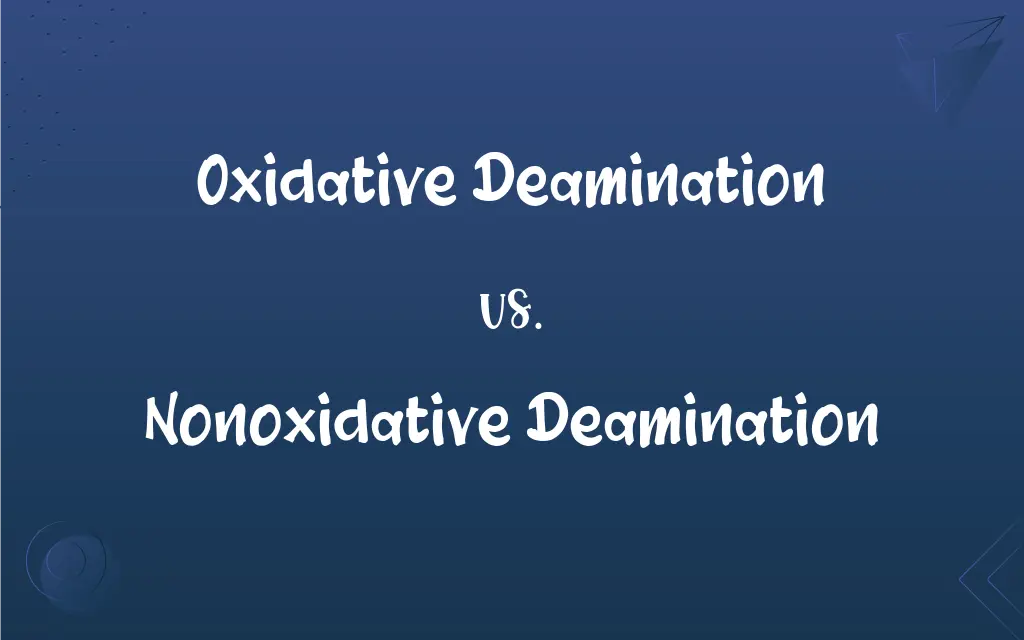Oxidative Deamination vs. Nonoxidative Deamination: What's the Difference?
Edited by Harlon Moss || By Janet White || Published on February 26, 2024
Oxidative deamination removes an amino group with the aid of oxygen, forming ammonia; nonoxidative deamination does so without oxygen, typically forming an imine.

Key Differences
Oxidative deamination involves the removal of an amino group from an amino acid with the involvement of molecular oxygen, often producing ammonia and a keto acid. Nonoxidative deamination, in contrast, does not require oxygen and often involves the conversion of the amino group to an imine.
In oxidative deamination, the process typically generates hydrogen peroxide along with the keto acid, and it occurs in the mitochondria. Nonoxidative deamination, on the other hand, usually occurs in the cytosol and does not produce hydrogen peroxide.
The enzymes involved in oxidative deamination, like L-amino acid oxidase, require cofactors such as FAD or NAD(P)+. Nonoxidative deamination enzymes, such as glutamate dehydrogenase, may not require these cofactors.
Oxidative deamination plays a key role in the regulation of nitrogen balance and amino acid catabolism in the body. Nonoxidative deamination is more common in the metabolism of specific amino acids and in specific tissues.
The end products of oxidative deamination are often used in the urea cycle and other metabolic pathways. Nonoxidative deamination products have varied roles, including neurotransmitter synthesis and regulation of metabolic pathways.
ADVERTISEMENT
Comparison Chart
Oxygen Requirement
Requires oxygen
Does not require oxygen
Typical Location
Occurs in mitochondria
Usually occurs in cytosol
By-products
Produces hydrogen peroxide
Does not produce hydrogen peroxide
Enzymes and Cofactors
Involves enzymes like L-amino acid oxidase, requires cofactors
Enzymes may not require cofactors
Role in Metabolism
Regulates nitrogen balance, amino acid catabolism
Involved in specific amino acid metabolism, neurotransmitter synthesis
ADVERTISEMENT
Oxidative Deamination and Nonoxidative Deamination Definitions
Oxidative Deamination
Produces ammonia and a corresponding keto acid from an amino acid.
Oxidative deamination of glutamate forms alpha-ketoglutarate and ammonia.
Nonoxidative Deamination
Does not produce hydrogen peroxide as a by-product.
Nonoxidative deamination is involved in neurotransmitter synthesis.
Oxidative Deamination
Involves enzymes like L-amino acid oxidase and cofactors such as FAD.
Oxidative deamination in the kidney helps in amino acid breakdown.
Nonoxidative Deamination
A biochemical process that removes an amino group without the use of oxygen.
Nonoxidative deamination is essential in certain amino acid metabolic pathways.
Oxidative Deamination
Occurs primarily in mitochondria.
Oxidative deamination is key in regulating amino acid levels in cells.
Nonoxidative Deamination
Typically forms an imine from an amino acid.
Nonoxidative deamination occurs in the cytosol of cells.
Oxidative Deamination
Generates hydrogen peroxide as a by-product.
Oxidative deamination plays a crucial role in nitrogen metabolism.
Nonoxidative Deamination
Usually occurs in the cytosol.
Nonoxidative deamination contributes to nitrogen balance in the body.
Oxidative Deamination
A biochemical process involving oxygen to remove an amino group from amino acids.
In the liver, oxidative deamination converts excess amino acids into keto acids.
Nonoxidative Deamination
Enzymes involved may not require cofactors.
Nonoxidative deamination can regulate metabolic pathways in the brain.
FAQs
Where does oxidative deamination typically occur?
Mostly in mitochondria.
What are the by-products of oxidative deamination?
Ammonia, a keto acid, and hydrogen peroxide.
What is oxidative deamination?
It's a process where an amino group is removed from an amino acid using oxygen.
Where does nonoxidative deamination typically occur?
Mainly in the cytosol.
What enzymes are involved in nonoxidative deamination?
Various enzymes, often specific to the amino acid.
What is the role of nonoxidative deamination in metabolism?
It's involved in specific amino acid metabolism and neurotransmitter synthesis.
Are there by-products in nonoxidative deamination?
Yes, typically an imine and a keto acid.
What is nonoxidative deamination?
It's the removal of an amino group from an amino acid without using oxygen.
What enzymes are involved in oxidative deamination?
Enzymes like L-amino acid oxidase.
Does oxidative deamination require cofactors?
Yes, like FAD or NAD(P)+.
How does oxidative deamination affect nitrogen metabolism?
It helps in processing and excretion of nitrogen.
What is the role of oxidative deamination in metabolism?
It regulates nitrogen balance and amino acid catabolism.
Is hydrogen peroxide a by-product of nonoxidative deamination?
No, it's not.
Can oxidative deamination lead to detoxification?
Yes, by removing excess amino acids.
Can oxidative deamination affect amino acid levels in the blood?
Yes, by breaking down excess amino acids.
Does nonoxidative deamination contribute to nitrogen balance?
Yes, in specific pathways.
Is nonoxidative deamination involved in energy production?
Indirectly, through the metabolism of specific amino acids.
Do both processes occur in all tissues?
No, they are tissue-specific.
Are cofactors required for nonoxidative deamination?
Not necessarily.
Is nonoxidative deamination important for brain function?
Yes, particularly in neurotransmitter regulation.
About Author
Written by
Janet WhiteJanet White has been an esteemed writer and blogger for Difference Wiki. Holding a Master's degree in Science and Medical Journalism from the prestigious Boston University, she has consistently demonstrated her expertise and passion for her field. When she's not immersed in her work, Janet relishes her time exercising, delving into a good book, and cherishing moments with friends and family.
Edited by
Harlon MossHarlon is a seasoned quality moderator and accomplished content writer for Difference Wiki. An alumnus of the prestigious University of California, he earned his degree in Computer Science. Leveraging his academic background, Harlon brings a meticulous and informed perspective to his work, ensuring content accuracy and excellence.
































































